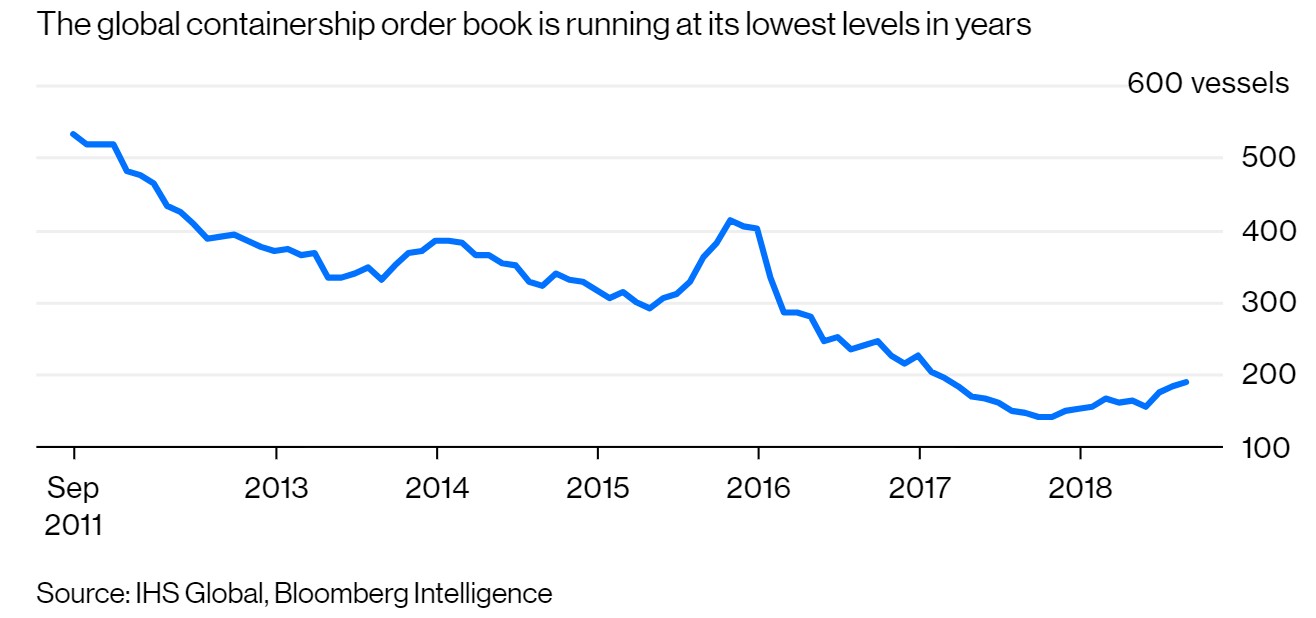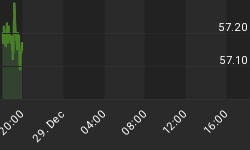Markets steady, U.S. economy strong, but risks ahead. Financial markets started out the week on solid footing awaiting key U.S. economic data. On Friday, another robust jobs report painted a picture of strength for the U.S. economy, although the markets are on edge as the warning signs of trouble elsewhere begin to pile up. Emerging market turmoil continues to ripple around the world. Meanwhile, the Trump administration is expected to ratchet up the trade war with China any day now.
Chart of the Week

- Bookings for container ships have dropped to their lowest level in years, raising fears of a trade slowdown.
- In fact, data on trade activity is showing a lot of red flags. The world trade monitor published by CPB Netherlands Bureau for Economic Policy Analysis turned negative in the second quarter for the first time since 2015.
- Negative readings on the CPB index tend to coincide with recessions.
Markets
Dollar strength could be temporary. The U.S. dollar has gained a lot of ground this year at the expense of emerging markets, wreaking havoc on the currencies of the developing world. But the dollar has not fared as well against major currencies, such as the euro or the yen. In fact, some analysts argue that the stronger greenback this year is a blip in a longer-term trend of a weakening dollar. As the effects of last year’s tax cuts wear off, and the U.S. economy cools, the dollar could lose ground.
Trump preparing $267 billion in tariffs. President Trump said on Friday that his administration is preparing $267 billion in tariffs on China, which would come on top of the soon-to-be-announced $200 billion in tariffs on China. “I hate to say this, but behind that there is another $267 billion ready to go on short notice if I want,” he said. “That changes the equation.”
Related: The Latin American Crypto Boom Is Underway
Goldman: Bear-market risks at a multi-decade peak. An indicator published by Goldman Sachs suggests that financial markets are facing serious headwinds. The bear-market indicator is at its highest since 1969, a metric that takes into account equity valuations, growth momentum, unemployment, inflation and the yield curve. Historically, a reading this high has preceded a bear market.
Commodities
Geopolitical tensions increase pricing volatility. A new report from Willis Towers Watson finds that rising geopolitical tensions are affecting supply chains around the world, which is leading to increased volatility in the mining sector. “This is a critical time for the mining sector. Although there were encouraging signs of a rise in commodity prices earlier this year, it is clear that things are looking bleaker for the rest of 2018,” Graham Knight, Head of Downstream Natural Resources said in a statement. “Meanwhile increased geopolitical tensions are clearly posing significant uncertainty for the industry.”
Gold prices back below $1,200. Gold prices fell below $1,200 in mid-August on dollar strength, before rebounding a bit. But gold fell below that threshold once again in recent days. The strong U.S. jobs report last week, which showed rising wages and an incredibly low unemployment rate, adds more fuel to the fire for the Federal Reserve to hike interest rates. Ultimately, that weighs on gold.
Copper prices near 14-month low. Copper prices have been battered in the last few weeks, dropping close to a 14-month low. Expectations of a serious escalation in the U.S.-China trade war could present a serious hit to copper demand. “Everyone is waiting for the tariffs to be applied or not. Rebounds in metals (prices) will simply not get going while you have these macro fears,” Societe Generale analyst Robin Bhar said, according to Reuters.
Energy
Oil prices up on slowing rig count, Iran losses. Oil prices saw a lift in early trading on Monday after another weak rig count report from Baker Hughes, which shows that the U.S. rig count continues to stagnate, and in fact, has been mostly flat since May. Separately, news about Iran oil exports continues to look worse than previously expected. Some analysts say this adds up to a bullish picture. “A higher oil price scenario is built on lower exports from Iran due to U.S. sanctions, capped U.S. shale output growth, instability in production in countries like Libya and Venezuela and no material negative impact from a U.S./China trade war on oil demand in the next 6-9 months,” Harry Tchilinguirian, oil strategist at French bank BNP Paribas, said at the Reuters Global Oil Forum. “We see Brent trading above $80 under (that) scenario.”
Armed attacks in Libya and Iraq. Several armed men attacked the headquarters of Libya’s National Oil Company in Tripoli on Monday, and early reports indicated there were some explosions as well. The attacks were beaten back by security forces and there were no reports of any effects on oil operations. Nevertheless, it is another reminder of the instability in the North African country. Meanwhile, instability continues to rock Basra, Iraq’s oil hub in the south. For now, oil operations appear to be unaffected, but the region is home to vast majority of the country’s oil production. Against this backdrop, Iraq’s oil production is running at record levels, averaging about 4.36 million barrels per day.
Related: Markets Open Flat As Investors Take Profits From Recent Rally
Natural gas to overtake oil as North America’s top source of energy. Oil will lose its top spot as North America’s largest primary energy source this year, according to DNV GL. Natural gas will surpass crude oil as the continent continues to gradually shift towards more gas-fired electricity and crude oil demand for transportation remains flat. "Energy efficiency is going to outpace the growth in GDP (gross domestic product), that's the main reason why energy demand is peaking," DNV GL's group president and CEO Remi Eriksen told CNBC on Monday. "(And) there will be a massive change in technology in the transport sector, not only on the roads but also at sea," he added.
Cryptocurrencies
Bitcoin prices stabilize after selloff. Bitcoin plunged last week, falling by more than 15 percent over the course of four days. Prices stabilized over the weekend, and as of early Monday, Bitcoin was up slightly at just over $6,200. Bitcoin and other digital currencies have been hit with a raft of bad news lately, from scams to regulatory crackdowns and waning enthusiasm. Last week, a major trading platform, ShapeShift AG, said it would begin requesting personal information from users, which goes against the allure of anonymity that cryptocurrencies have promised. Also, news surfaced last week that Goldman Sachs is paring back its plans on trading in cryptocurrencies (more below), another setback for the industry.
Goldman backs out of Bitcoin. Goldman Sachs is reportedly pulling back on its plans to set up a cryptocurrency trading desk. The decision comes as a growing number of traditional financial players have abandoned or delayed cryptocurrency plans in the wake of the burst in last year’s crypto bubble, according to Bloomberg. The report on Goldman’s decision helped spark a selloff in digital currencies last week. “The expectation of adoption by Wall Street has been a major theme for the cryptocurrency market for the last year, so any kind of updates on that can certainly move the prices,” Mati Greenspan, senior market analyst at currency trader eToro, told Bloomberg. “Even if it’s not true, it should be enough to cause a minor selloff like this in cryptocurrencies.”
SEC temporarily suspended trading in two crypto-linked securities. On Sunday, the U.S. Securities and Exchange Commission temporarily suspended trading in two securities that have links to cryptocurrencies. The SEC cited confusion over the assets, which include Bitcoin Tracker one and Ether Tracker One. The suspension will last through September 20. The spate of bad news took the cryptocurrency bear market to a fresh 10-month low, according to Bloomberg.
By Josh Owens for Safehaven.com
More Top Reads From Safehaven.com
















